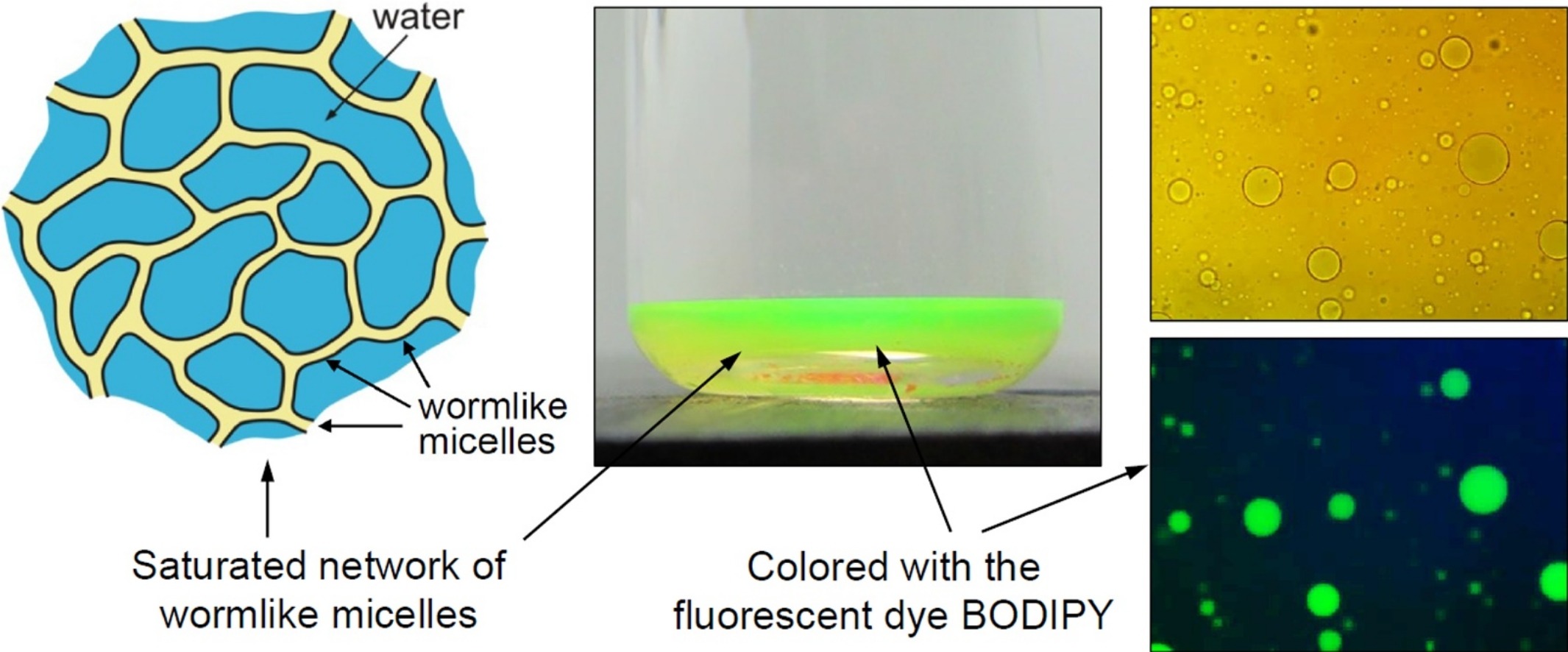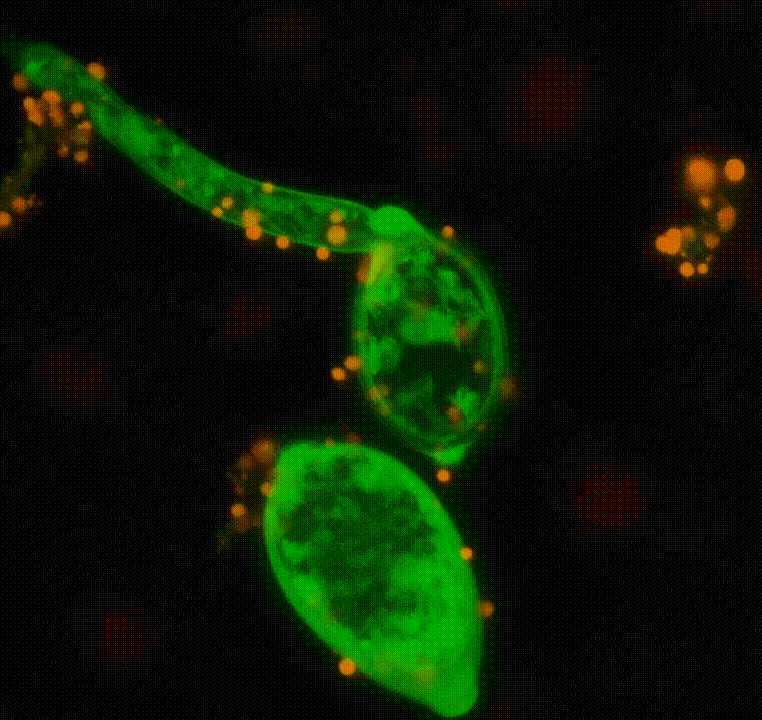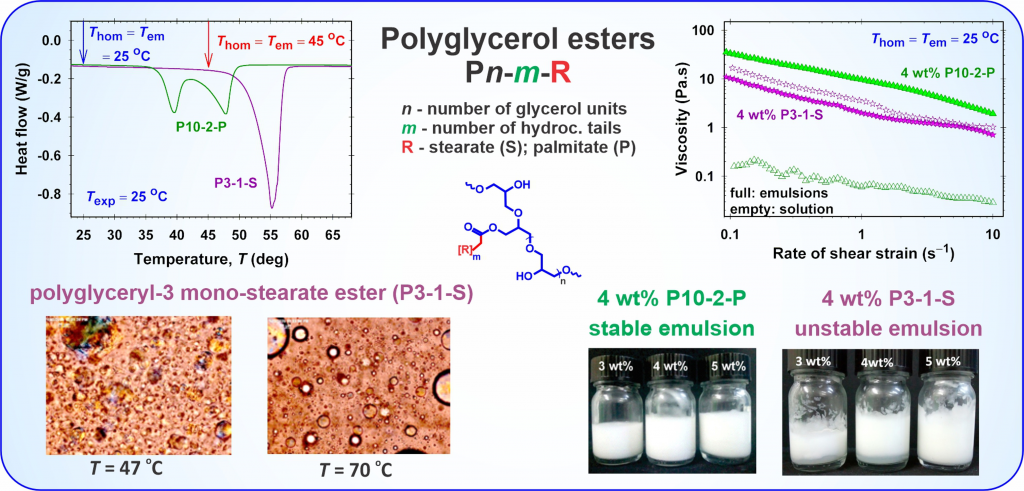
Mihail T. Georgiev, Ph.D.
Interests
- Hydrocolloids
- Complex fluids
- Surface and Interface
Publications
Featured publications
Conformational and rheological behavior of kappa carrageenan in glycerol: Effects of sodium salts and preparation temperature
Kappa carrageenan (KC), a sulfated polysaccharide derived from red seaweed, exhibits distinct gelation properties that are influenced by ionic strength and thermal conditions. While its behavior in aqueous media is well-established, understanding KC’s gelation mechanisms in non-aqueous solvents (like glycerol) remains limited. This study investigates the conformational and rheological properties of kappa carrageenan in glycerol, focusing on the effects of sodium salts (NaCl, NaH2PO4, Na3PO4) at varying concentrations and preparation temperatures (60 °C and 80 °C). Rheological measurements reveal distinct viscosity trends influenced by salt type and temperature, highlighting the interplay between ionic interactions and KC’s conformational transitions. Phosphate salts significantly enhance network elasticity and stability, especially at intermediate concentrations, whereas NaCl induces weaker, viscosity-dominated structures. Atomic force microscopy imaging provides complementary nanoscale insights, showcasing salt-specific structural transitions from looped to branched networks, alongside a temperature-dependent helix-to-coil transformation. These results illustrate how the precisely tuning ionic conditions and the preparation temperatures in glycerol media can effectively modulate KC’s structure and viscoelastic properties. This deeper understanding facilitates targeted design and optimization of carrageenan-based materials across food, pharmaceutical, cosmetic, and biotechnological applications.

Phase separation of saturated micellar network and its potential applications for nanoemulsification
Phase separation of saturated micellar network, as a result of cross-linking of branched micelles, is established in mixed solutions of the anionic surfactant sodium laurylethersulfate (SLES) and the zwitterionic cocamidopropyl betaine (CAPB) in the presence of divalent counterions: Ca2+, Zn2+ and Mg2+. The saturated network appears in the form of droplets, which are heavier than water and sediment at the bottom of the vessel. In the case of Mg2+, the sedimented drops coalesce and form a separate multiconnected micellar phase – a supergiant surfactant micelle. For this phase, the rheological flow curves show Newtonian and shear-thinning regions. The appearance/disappearance of the Newtonian region marks the onset of formation of saturated network. The addition of small organic molecules (fragrances) to the multiconnected micellar phase leads to an almost spontaneous formation of oil-in-water nanoemulsion. The nanoemulsification capacity of the multiconnected micellar phase decreases with the rise of the volume of the oil molecule. A possible role of the network junctions in the nanoemulsification process can be anticipated. The properties of the multiconnected micellar phases could find applications in extraction and separation processes, in drug/active delivery, and for nanoemulsification at minimal energy input.

Rheology of particle/water/oil three-phase dispersions: Electrostatic vs. capillary bridge forces
Hypothesis Particle/water/oil three-phase capillary suspensions possess the remarkable property to solidify upon the addition of minimal amount of the second (dispersed) liquid. The hardening of these suspensions is due to capillary bridges, which interconnect the particles (pendular state). Electrostatic repulsion across the oily phase, where Debye screening by electrolyte is missing, could also influence the hardness of these suspensions. Experiments We present data for oil-continuous suspensions with aqueous capillary bridges between hydrophilic SiO2 particles at particle volume fractions 35–45%. The hardness is characterized by the yield stress Y for two different oils: mineral (hexadecane) and vegetable (soybean oil). Findings and modelling The comparison of data for the “mirror” systems of water- and oil-continuous capillary suspensions shows that Y is lower for the oil-continuous ones. The theoretical model of yield stress is upgraded by including a contribution from electrostatic repulsion, which partially counterbalances the capillary-bridge attraction and renders the suspensions softer. The particle charge density determined from data fits is close to that obtained in experiments with monolayers from charged colloid particles at oil/water interfaces. The results could contribute for better understanding, quantitative prediction and control of the mechanical properties of solid/liquid/liquid capillary suspensions.

Most recent publications
Enhancing RNAi efficiency in Phytophthora infestans using cell-penetrating peptide TAT
Synthetic double-stranded RNA (dsRNA) can be used to control plant pests and pathogens by inducing RNA interference (RNAi) in the cells of the target organism. However, this could be challenging especially in species with naturally lower dsRNA uptake capabilities, such as the late blight pathogen Phytophthora infestans. Short peptides that readily cross the cell membrane, called cell-penetrating peptides (CPPs), have been explored as molecular carriers for the delivery of therapeutic molecules, including proteins and nucleic acids. Here, we investigate the possibility of using CPPs to facilitate the uptake of dsRNA and increase the RNAi efficiency in P. infestans. We compared the penetration efficiency of four well-known CPPs in sporangia and hyphae and found that the cationic peptide derived from the transactivator of transcription protein (TAT) of the human immunodeficiency virus (HIV) is internalized efficiently, rapidly, and in an energy-independent manner. The TAT peptide also interacts with dsRNA electrostatically by forming particles with increased affinity towards the cell walls of P. infestans. In hyphae treated with TAT/dsRNA complex, the accumulation of high quantities of TAT peptide was observed, however, only a limited amount of dsRNA was detected. Nonetheless, TAT/dsRNA complex proved functional by triggering RNAi response by silencing the G-protein β-subunit gene (Pigpb1) in P. infestans in contrast to the naked dsRNA. Additionally, we found that the TAT peptide has a moderate ability to penetrate plant leaves and can move through the xylem. Our results indicate that CPPs can improve the efficiency of dsRNA-induced RNAi in P. infestans and have potential in the development of novel plant protection formulations.

Aqueous Solutions of Oil-Soluble Polyglycerol Esters: Structuring and Emulsifying Abilities
The polyglycerol esters (PGEs) of fatty acids have a wide range of HLB values and applications in diverse industries, such as pharmaceuticals and cosmetics. While the physicochemical properties of oil-soluble PGEs dissolved in oil phases are well studied in the literature, there is no information on their structuring in aqueous phases and emulsifying abilities. We combined rheological and differential scanning calorimetry (DSC) measurements and microscopy observations to characterize the dependence of oil-soluble PGE structuring in aqueous phases on the PGE concentration, the temperature of solution homogenization, and the PGE molecular structure. Excellent correlations between the considerable changes in solution viscosity and the temperatures of the two endo- and exothermic peaks in the DSC thermograms are observed. Single-tail PGE molecules, which have a higher number of polyglycerol units, are better organized in networks, and the viscosity of their aqueous solutions is higher compared to that of the respective double-tail PGE molecules. PGEs exhibit good emulsifying ability and the viscosity of the produced emulsions at room temperature can differ by orders of magnitudes depending on the temperature of emulsification. The reported properties of oil-soluble PGEs could be of interest for increasing the range of their applicability in practice.

Disperse systems and rheology in clean technologies – lab 6.2 capabilities and developments
Laboratory 6.2 “Disperse systems and rheology in clean technologies” within WP 6 “Nano-structured materials and disperse systems in clean technologies” aims at the development of new systems for clean technologies and nanotechnologies in various scientific and technological areas: new cleaning agents for hard surfaces; encapsulation and controlled release of reagents; wetting and dewetting processes. The main objectives are to conduct experimental and theoretical research and development of new dispersed systems through the inclusion of new raw materials and innovative materials, and to develop and apply theoretical models of the interactions and stability of complex dispersed systems. High scientific output of Lab 6.2 is manifested via 21 scientific publications in the fields of Dispersion Chemistry, Chemical and Materials Sciences for the period 2018 – 2024 (8 articles in Q1 journals, 6 in Q2, and 7 materials in Q4). Optimized compositions of cleaning formulations for hard surfaces with sulfonated methyl esters have been obtained [1]. New theoretical models for the interactions that determine the structures in micellar systems have been developed and applied [2]. New phenomena such as vortexing [3] and nanoemulsification [4] have been described. New methods have been proposed for obtaining emulsions and foams from triglyceride phases [5]. The role of the components and compositions for the rheology [6], wetting, and cleaning [7] has been demonstrated.
Temperature-induced formation of a bicontinuous phase: cryo-tem visualization and Cahn–Hilliard interpretation
Cryogenic transmission electron microscopy (Cryo-TEM) provides direct visualization of bicontinuous sponge (L₃) phases, where a surfactant bilayer meanders through space, dividing solvent into two continuous domains. Temperature increase destabilizes lamellar order by lowering the bending rigidity and driving the Gaussian modulus toward values that favor handle formation. We captured this transition as the loss of layered registry and the emergence of a labyrinthine bilayer network rich in saddle regions. A Cahn-Hilliard-type phase-field model reproduces these features: small shifts in the free-energy landscape and interfacial penalty are sufficient to convert stripe-like lamellae into bicontinuous structures. This synergy between imaging and modeling highlights how thermal fluctuations push membranes into topologies inaccessible at lower temperatures, offering a predictive framework for designing temperature-responsive surfactant systems.
Conformational and rheological behavior of kappa carrageenan in glycerol: Effects of sodium salts and preparation temperature
Kappa carrageenan (KC), a sulfated polysaccharide derived from red seaweed, exhibits distinct gelation properties that are influenced by ionic strength and thermal conditions. While its behavior in aqueous media is well-established, understanding KC’s gelation mechanisms in non-aqueous solvents (like glycerol) remains limited. This study investigates the conformational and rheological properties of kappa carrageenan in glycerol, focusing on the effects of sodium salts (NaCl, NaH2PO4, Na3PO4) at varying concentrations and preparation temperatures (60 °C and 80 °C). Rheological measurements reveal distinct viscosity trends influenced by salt type and temperature, highlighting the interplay between ionic interactions and KC’s conformational transitions. Phosphate salts significantly enhance network elasticity and stability, especially at intermediate concentrations, whereas NaCl induces weaker, viscosity-dominated structures. Atomic force microscopy imaging provides complementary nanoscale insights, showcasing salt-specific structural transitions from looped to branched networks, alongside a temperature-dependent helix-to-coil transformation. These results illustrate how the precisely tuning ionic conditions and the preparation temperatures in glycerol media can effectively modulate KC’s structure and viscoelastic properties. This deeper understanding facilitates targeted design and optimization of carrageenan-based materials across food, pharmaceutical, cosmetic, and biotechnological applications.


